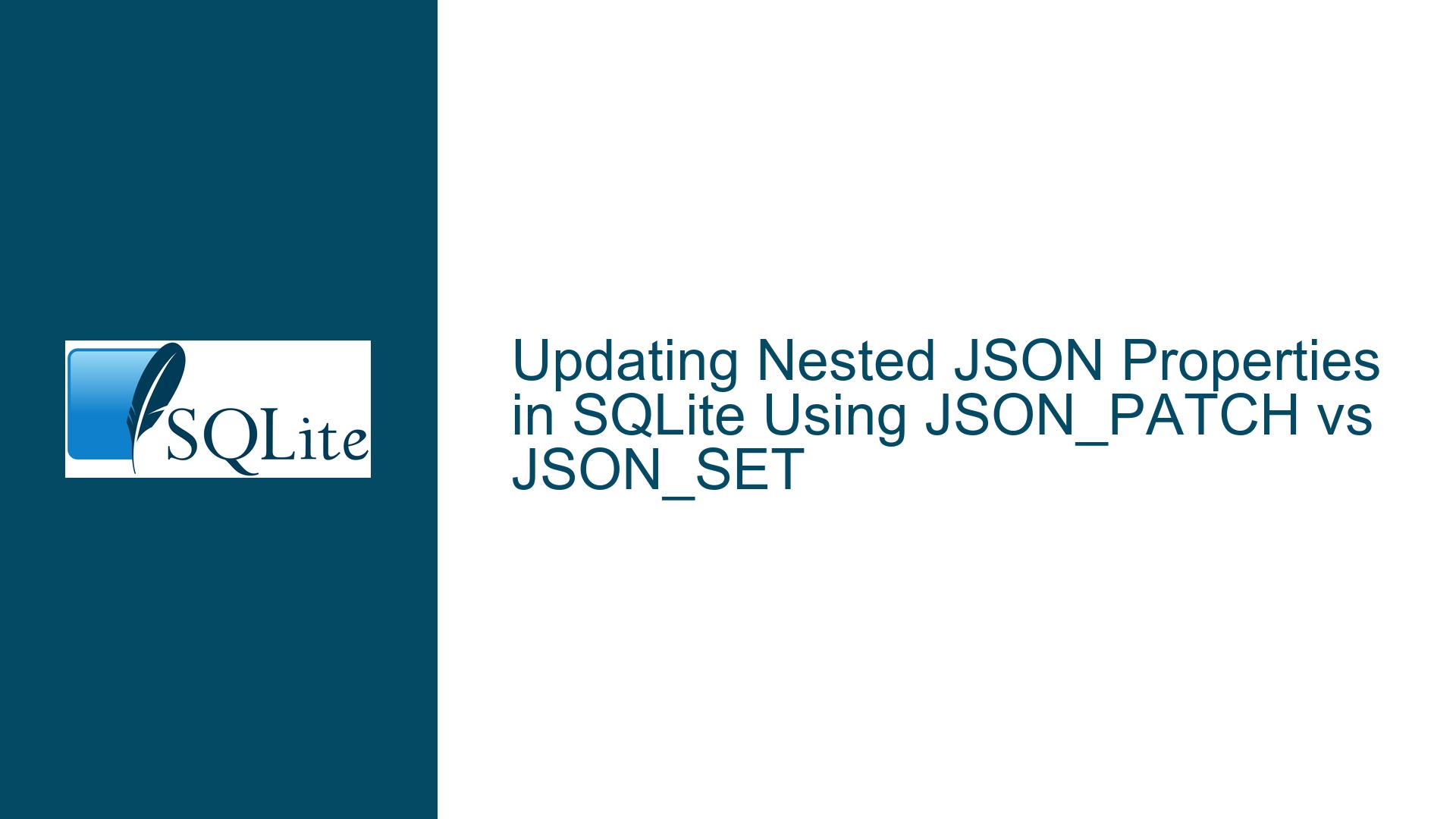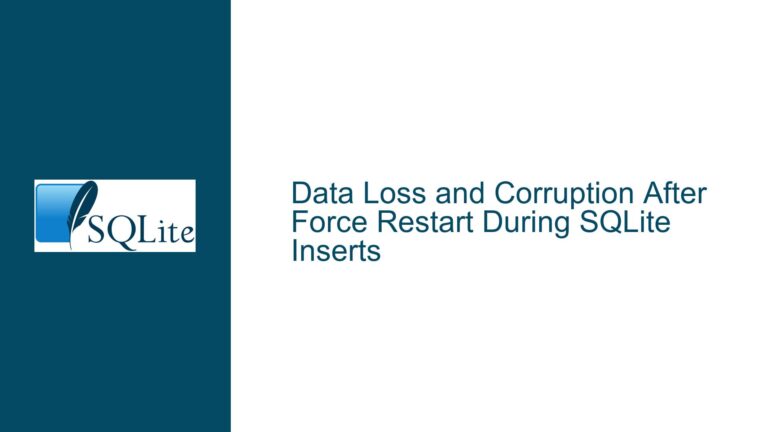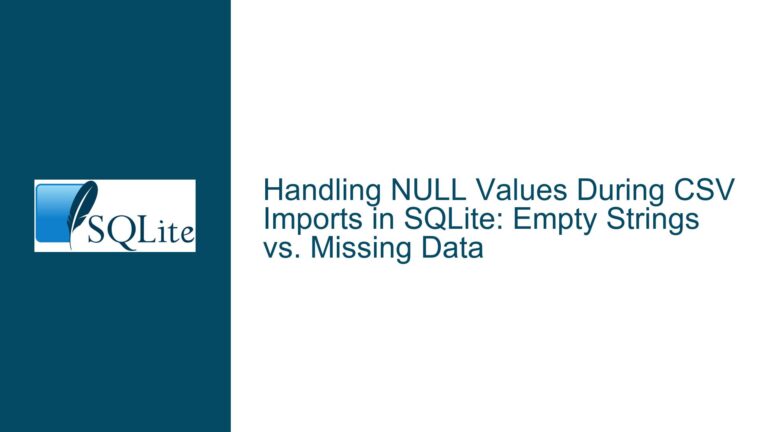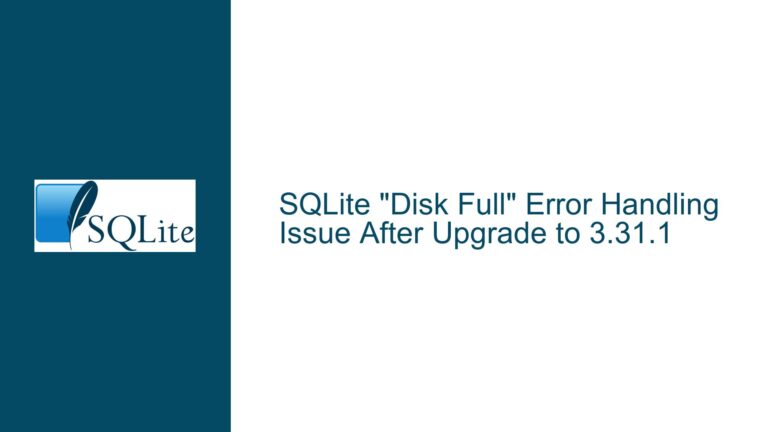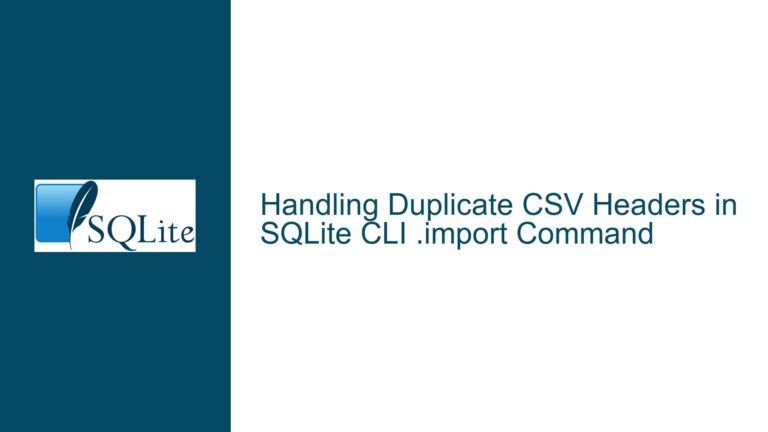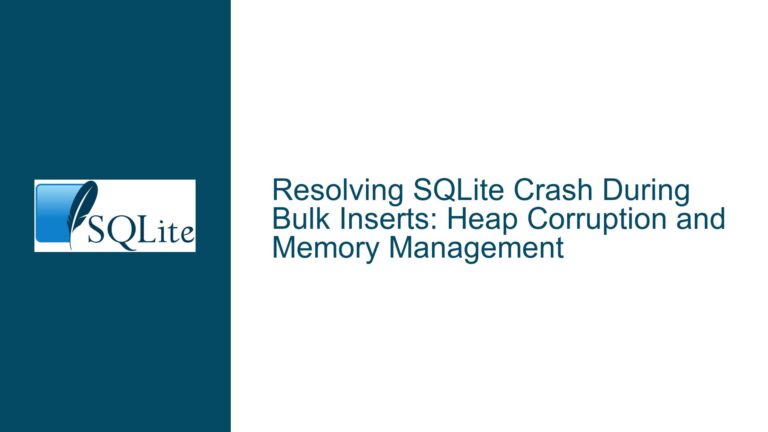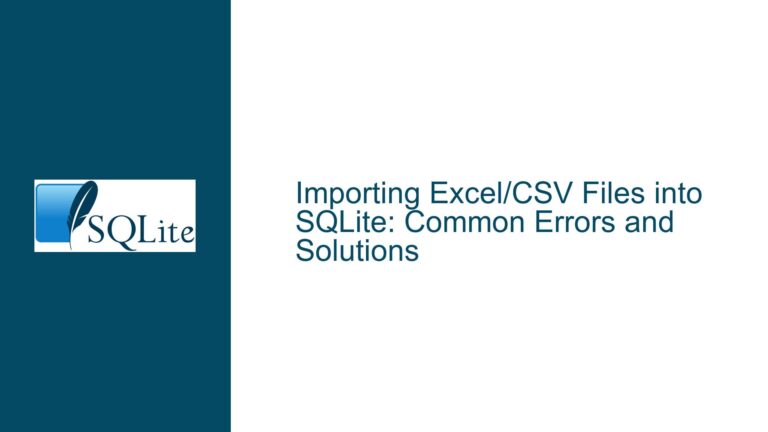Updating Nested JSON Properties in SQLite Using JSON_PATCH vs JSON_SET
Challenges in Modifying Multiple Nested JSON Properties
JSON Structure Modification Requirements and Functional Limitations
The core challenge revolves around modifying multiple properties within a nested JSON object stored in an SQLite database column. The objective is to update or insert key-value pairs at non-root levels of the JSON hierarchy without prior knowledge of existing structure or property names. This requires handling three critical constraints:
- Path Depth Complexity: Operations must target intermediate nodes (e.g.,
$.a.blevel) rather than root-level properties - Dynamic Property Sets: The solution must accommodate arbitrary numbers of properties with unknown names at runtime
- Idempotent Modifications: Updates should handle both existing property overwrites and net-new property insertions
SQLite’s native JSON functions (JSON_SET, JSON_INSERT, JSON_REPLACE) operate on single-path specifications, forcing developers to chain multiple function calls when modifying sibling properties at the same JSON depth level. This becomes unwieldy when dealing with dynamic property sets generated from application logic or external data sources.
JSON Function Behavioral Differences and Merge Strategies
The observed difficulties stem from fundamental differences in how SQLite’s JSON manipulation functions handle object modification:
1. Single-Property vs Multi-Property Operations
JSON_SET '$.a.b.c'modifies one property per callJSON_PATCHperforms recursive merge of two JSON objects
2. Path Resolution Mechanics
- Path-based functions require explicit navigation (
$.level1.level2.target) - Merge-based functions operate on structural equivalence between objects
3. Type Coercion and Casting
JSON_SETpreserves JSON types through SQL expressionsJSON_PATCHrequires valid JSON input for both operands
4. Null Handling
JSON_SETremoves properties when setting to SQL NULLJSON_PATCHpreserves nulls as JSON null values
5. Array Handling
- Both functions treat arrays as atomic values during modification
- No native support for array element patching exists
The critical limitation emerges when attempting batch modifications at nested levels: JSON_SET requires enumerating every target path, while JSON_PATCH enables merging a preconstructed partial object into the existing structure. This makes JSON_PATCH superior for dynamic multi-property updates despite its higher initial complexity.
Comprehensive Modification Workflow with Validation Protocols
Step 1: Input Sanitization and Type Enforcement
Construct a temporary table or CTE to validate and normalize input properties:
WITH props(key, prop, value) AS (
SELECT
CAST(key AS INTEGER),
json_valid(prop) AS prop,
json_type(value)
FROM raw_input
WHERE json_type(value) IN ('integer','text','real','boolean')
)
This ensures:
- Key values are integers for ordered processing
- Property names are valid JSON keys
- Values conform to JSON-supported types
Step 2: Partial Object Construction
Use json_group_object() with ordering guarantees:
pre_patch AS (
SELECT
json_group_object(prop, value) AS fresh_data
FROM props
ORDER BY key ASC
)
The ORDER BY clause prevents non-deterministic ordering in the generated JSON object, crucial for reproducible patches.
Step 3: Structural Isolation with JSON_EXTRACT
Extract the target sub-object while preserving parent structure:
existing_subobject AS (
SELECT
json_extract(state, '$.a.b') AS b_node,
state AS original_state
FROM main_data
)
This isolation prevents accidental overwrites of sibling properties during the merge operation.
Step 4: Type-Checked Merge Operation
Apply defensive casting before patching:
merged_data AS (
SELECT
json_patch(
json(existing_subobject.b_node),
json(pre_patch.fresh_data)
) AS patched_b_node
FROM existing_subobject, pre_patch
)
Explicit json() casting ensures both operands are treated as JSON objects rather than text blobs.
Step 5: Structural Reintegration
Safely replace the modified sub-object:
UPDATE main_data
SET state = json_replace(
original_state,
'$.a.b',
json(merged_data.patched_b_node)
)
FROM merged_data;
The json_replace function preserves all existing properties outside the modified path while maintaining original ordering of unmodified elements.
Optimization Techniques
A. Partial Object Caching
Materialize frequently accessed sub-objects in temporary tables:
CREATE TEMP TABLE IF NOT EXISTS cached_subobjects AS
SELECT
rowid,
json_extract(state, '$.a.b') AS b_node
FROM main_data;
B. Batch Patching
Process multiple records simultaneously with window functions:
WITH numbered_props AS (
SELECT
row_number() OVER (ORDER BY key) AS rn,
prop,
value
FROM props
)
C. Differential Patching
Generate minimal patch sets by comparing existing values:
effective_props AS (
SELECT
p.prop,
p.value
FROM props p
LEFT JOIN json_each(
(SELECT b_node FROM cached_subobjects WHERE rowid = 1)
) e ON e.key = p.prop
WHERE e.value IS NULL OR e.value <> p.value
)
Validation Checks
1. Merge Conflict Detection
SELECT
json_valid(json_patch(A,B)) AS patch_valid,
json_type(json_patch(A,B)) AS result_type
FROM (SELECT json('{"a":1}') AS A, json('{"a":"text"}') AS B);
Checks for type mismatches that would invalidate the merged object.
2. Path Existence Verification
SELECT
json_extract(state, '$.a.b') IS NOT NULL AS target_exists
FROM main_data
LIMIT 1;
Ensures the target merge path exists before attempting updates.
3. Rollback Safety
Wrap all updates in transaction blocks with pre-update snapshots:
BEGIN;
ATTACH ':memory:' AS rollback_store;
CREATE TABLE rollback_store.pre_update_state AS SELECT * FROM main_data;
-- Perform update operations here
-- If error occurs:
ROLLBACK;
INSERT INTO main_data SELECT * FROM rollback_store.pre_update_state;
COMMIT;
Alternative Approaches
1. JSON_SET Chaining
For known, fixed property sets:
UPDATE main_data
SET state =
json_set(
json_set(
json_set(state, '$.a.b.c', 100),
'$.a.b.d', 50
),
'$.a.b.e', 75
);
Becomes impractical beyond 3-4 properties due to SQL verbosity.
2. Hybrid JSON_PATCH/JSON_SET
Combine both approaches for mixed update types:
UPDATE main_data
SET state = json_patch(
json_set(state, '$.a.b.new_prop', 'value'),
json('{"a":{"b":{"e":75}}}')
);
3. Application-Side Templating
Generate SQL with application code:
props = {'c':100, 'd':50, 'e':75}
paths = [f"'$.a.b.{k}', {v}" for k,v in props.items()]
query = f"UPDATE main_data SET state = json_set(state, {', '.join(paths)})"
Introduces security risks unless strictly controlled.
Performance Considerations
1. Index Utilization
Create virtual columns on frequently accessed JSON paths:
CREATE TABLE main_data(
state TEXT,
a_b GENERATED ALWAYS AS (json_extract(state, '$.a.b')) VIRTUAL
);
CREATE INDEX idx_a_b ON main_data(json_valid(a_b));
2. Write Amplification
Benchmark batch vs single updates using:
EXPLAIN QUERY PLAN
UPDATE main_data SET state = ...;
Look for SCAN TABLE vs SEARCH TABLE differences.
3. Memory Thresholds
Monitor SQLite’s memory usage during large JSON operations:
PRAGMA soft_heap_limit = 1000000; -- 1MB limit
Error Handling Patterns
1. Constraint Violations
Add JSON schema validation:
CREATE TABLE main_data(
state TEXT CHECK (
json_valid(state)
AND json_extract(state, '$.a.b') IS NOT NULL
)
);
2. Type Enforcement
Validate JSON types during input:
CREATE TRIGGER validate_types BEFORE UPDATE ON main_data
BEGIN
SELECT
CASE WHEN json_type(new.state, '$.a.b.e') NOT IN ('integer','null')
THEN RAISE(ABORT, 'Invalid type for $.a.b.e')
END;
END;
3. Merge Failure Recovery
Implement error logging for failed patches:
CREATE TABLE json_merge_errors(
timestamp DATETIME,
original_state TEXT,
patch_data TEXT,
error_message TEXT
);
INSERT INTO json_merge_errors
SELECT
datetime('now'),
state,
fresh_data,
'Merge failure'
FROM main_data, pre_patch
WHERE json_error_position(json_patch(
json_extract(state, '$.a.b'),
fresh_data
)) IS NOT NULL;
Advanced Techniques
1. Versioned JSON Modifications
Track changes using JSON Patch format:
CREATE TABLE json_change_log(
change_id INTEGER PRIMARY KEY,
patch TEXT,
applied_at DATETIME DEFAULT CURRENT_TIMESTAMP
);
-- Store patches instead of full states
INSERT INTO json_change_log(patch)
VALUES ('[{"op":"replace","path":"/a/b/e","value":75}]');
2. Partial Indexing on JSON Paths
Optimize query performance for specific sub-objects:
CREATE INDEX idx_a_b_e ON main_data(
json_extract(state, '$.a.b.e')
) WHERE json_valid(state) AND json_type(state, '$.a.b.e') = 'integer';
3. Merge Conflict Resolution Policies
Implement custom merge strategies via SQL functions:
SELECT
json_patch(
json_patch('{}', COALESCE(old_data, '{}')),
json_patch('{}', COALESCE(new_data, '{}')),
'{"conflictStrategy":"ours"}'
);
Requires loading JSON extension modules with custom conflict handlers.
Cross-Database Comparison
1. PostgreSQL jsonb_set()
Allows multiple path updates in single call:
UPDATE table
SET data = data::jsonb
#- '{a,b,c}'
|| '{"a":{"b":{"c":100, "d":50}}}'::jsonb
Shows alternative syntax approaches in other DBMS.
2. MySQL JSON_MERGE_PATCH()
Similar behavior to SQLite’s JSON_PATCH:
UPDATE table
SET col = JSON_MERGE_PATCH(col, '{"a":{"b":{"c":100}}}')
Highlights standardization efforts in JSON manipulation functions.
3. Oracle json_mergepatch()
Implements RFC 7396 standard merging:
UPDATE table
SET col = json_mergepatch(col, '{"a":{"b":null}}')
Demonstrates varying null handling across implementations.
Best Practice Recommendations
Prefer JSON_PATCH for Multi-Property Updates
- More maintainable than chained JSON_SET calls
- Better performance with large property sets
- Clear intent signaling in SQL code
Isolate Merge Operations
- Perform merges on extracted sub-objects
- Prevents accidental overwrites of parent properties
- Enables transaction-safe rollbacks
Validate Early, Validate Often
- Check JSON validity before modification attempts
- Enforce type constraints at input boundaries
- Use generated columns for frequent access patterns
Monitor Performance Characteristics
- Profile query plans for JSON operations
- Consider partial indexing strategies
- Benchmark memory usage during bulk updates
Implement Defensive Error Handling
- Use CHECK constraints for structural validation
- Log failed merge attempts
- Enclose operations in transactions with savepoints
This comprehensive approach addresses both the immediate technical challenge of nested JSON updates and establishes robust patterns for maintaining complex JSON structures in SQLite environments. The combination of SQLite’s native JSON functions with careful transaction design and validation logic creates a maintainable solution adaptable to evolving schema requirements.
